NSW
Art Gallery of New South Wales
The time-based art conservation team, including conservators Asti Sherring and Carolyn Murphy, have been busy organising ‘Towards a flexible future: managing time-based media artworks in collections’, Tuesday 4th June – Friday 7th June 2019. The 4-day event includes a half-day symposium and 3.5-day workshop to forge greater understanding of the crisis affecting time-based artworks in public collections and to build a collaborative and supporting network between Australian, New Zealand and Asian institutions for ongoing support and contact. This workshop will address the unique nature of time-based media artworks and support museum professionals in the development of and advocacy for holistic collection management and preservation strategies. Carolyn Murphy will also be presenting at the AICCM PSIG-SCC Conference: ‘Managing Risks to Collections’, February 2019, where she will be discussing the establishment of best practice strategies across acquisition, display, documentation and preservation of the TBA collection at the AGNSW.
In frames conservation Margaret, Basia and Grace have been busy undertaking many ongoing projects and preparation of frames for loans. Significant conservation treatment has begun on the Carlo Cignani and workshop frame, a spectacular 17th century Italian carved object for the painting The five senses (1670s). Treatment will involve removal of overpaint and overgilding schemes to reveal the original gold and silver-coloured leaf beneath. This will be a lengthy and difficult project but with an incredibly rewarding outcome, and we look forward to sharing the results with you all later in the year!
Frames conservation have also been working hard in preparation for the upcoming symposium FRAME: Concept, History and Conservation to be held at AGNSW on April 3–5. This is sure to be a fantastic conference with many renowned international and Australian speakers, and we hope to see many of you there — Registrations are now open https://aiccm.org.au/civicrm/event/info%3Fid%3D39%26reset%3D1
In paper conservation, Analiese Treacy has recently been working as part of the team on the install of Heaven and Earth in Chinese Art show from the Palace Museum in Taiwan which includes National Treasures from their collection. Analiese has also been preparing a number of outward loans — notably a large group of works by Hans Heysen going on loan to NGV while also preparing a workshop for an upcoming Sydney Science Summit entitled ‘Illuminating the Possibilities’, which aims at introducing school-aged girls to a range of science related professions including conservation. Sarah Bunn returned from extended leave in February. Apart from the usual exhibition preparation, she is working with the collection systems manager to find a solution to give each of the 3000 books that comprise Chinese Bible a unique identification to enable tracking – hopefully before the deinstall in April! Rebecca Barnott-Clement has been condition reporting and preparing new acquisitions from the estate of the late Ray Hughes, and throughout January was working in preparing and condition checking works prior to digitisation. Intern Lucy King has been assisting the paper conservation team in entering condition reports onto the collection database for a recent gift of over 300 screen prints, as well as assisting with installation and iteration reports for the Dobell Drawing Biennial. In Asian art conservation, Lily Yang has been restoring the Yao Collection of ceremonial paintings.
 In reproduction framing, Tom Langlands is working on a reproduction Parkers frame for a 1919 Howard Ashton pastel. The ornaments were sourced from our archive of Parker moulds (image below). In mountcutting Jonathan Dennis has finalised preparing works on paper being displayed for the exhibition Brett Whiteley:drawing is everything, and has begun mounting and framing collection works for 20th/21st century Australian re-hangs and changeovers.
In reproduction framing, Tom Langlands is working on a reproduction Parkers frame for a 1919 Howard Ashton pastel. The ornaments were sourced from our archive of Parker moulds (image below). In mountcutting Jonathan Dennis has finalised preparing works on paper being displayed for the exhibition Brett Whiteley:drawing is everything, and has begun mounting and framing collection works for 20th/21st century Australian re-hangs and changeovers.
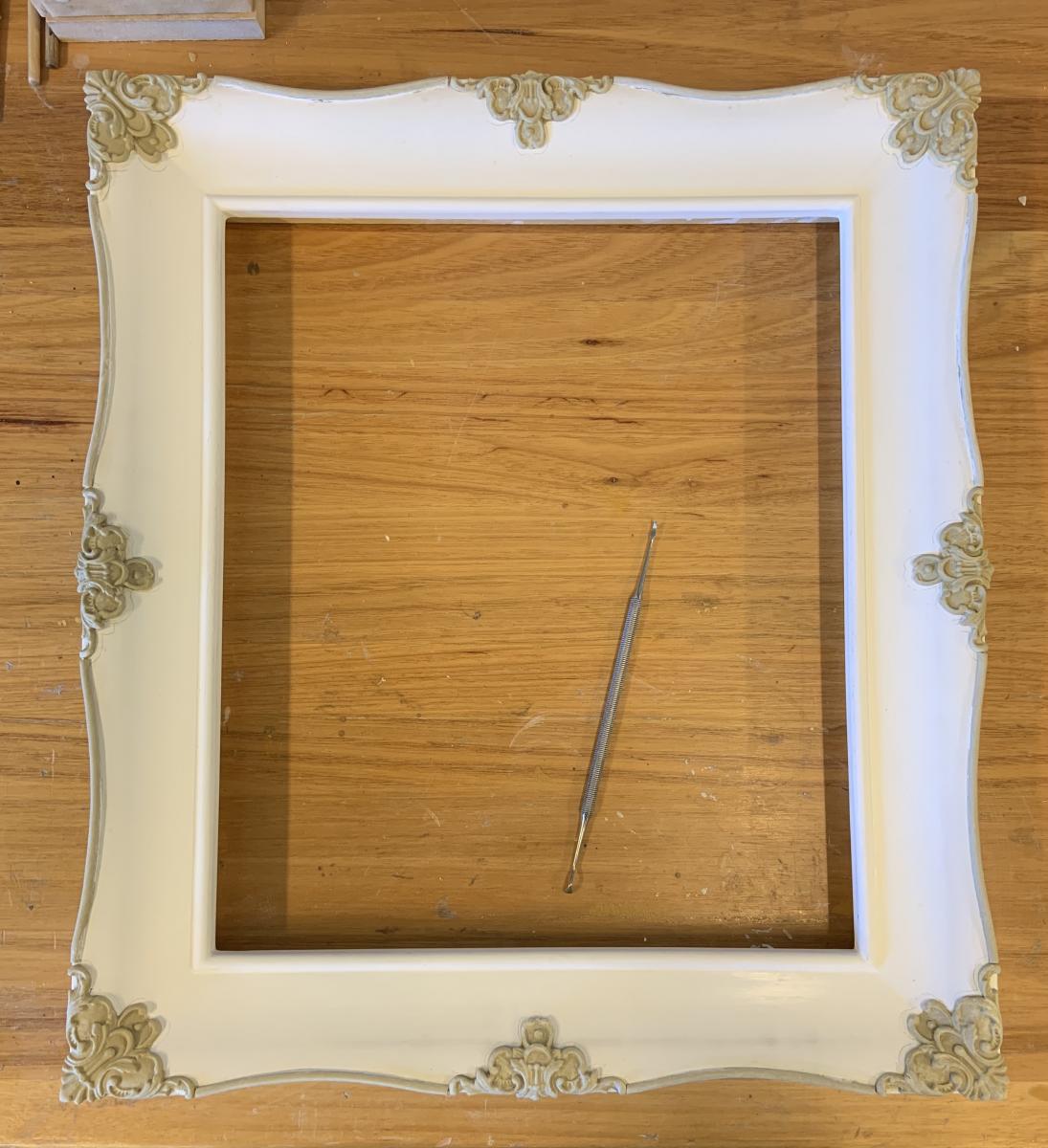
In objects conservation, Kerry Head has been working closely with Frances Cummings, exhibitions conservator, on the exhibition Heaven and Earth in Chinese Art from the Palace Museum in Taiwan. Kerry has also been working to process, treat and courier loans. Sofia Lo Bianco has been working closely with artists and curators on the upcoming Contemporary Art Exhibition The National, whilst also assessing new acquisitions. Melanie Barrett has been working on a benefactors’ funded project to conserve a collection of maquettes by Australian artist, Margel Hinder. Objects conservation intern, Elsa Kwok, has been providing administrative support for the AGNSW contribution to the ARC-funded Polymuse project.
Paula Dredge was the convenor of the highly successful international Infrared and Raman Users Group conference, which was hosted by AGNSW in December. Paula also gave a talk on the Artist’s Materials Archive at the ‘Heat & Dust: Artists, Archives, Art History’ conference at the Art Gallery of NSW, November 23–24. Celine DeCourlon has been taking care of loans (notably for the upcoming Ben Quilty exhibition) and other gallery affairs while Simon Ives has been carrying out the restoration of the 17th century Italian painting The Five Senses by Carlo Cignani. Melissa Harvey has taken up a training opportunity working with Gervais Battour at the National Gallery of Victoria for two weeks. Ellie Gifford has completed a project meticulously archiving and preparing for storage the contents from Lloyd Rees’ Northwood studio, which was generously donated to the gallery by Alan and Jancis Rees along with a donation for its care. We have also been lucky to have Creatability intern Naomi Malone working on archive reorganisation and research, and Marjolein Hupkes from the University of Amsterdam has begun a 6-month internship embarking on an X-ray analysis research project and the treatment of Arthur Streeton’s Passing showers.
Australian Museum
Social
Melissa Holt, conservation student at Melbourne University, has assisted the team with gallery maintenance duties in between her studies and work on the Pacific Collection relocation project.
Exhibitions
Megan Dean-Jones, Michael Kelly, Sheldon Teare and Rehan Scharenguivel have prepared a number of collection items for display in the Capturing Nature exhibition. Megan has carried out a number of complex treatments on some of the oldest taxidermied specimens in our collections — having to recreate an entire ear for a koala Phascolarctos cinereus specimen. Megan and Sheldon have prepared a number of Bird study skins and Herpetology skeleton material for a loan to the MCA.
Treatments/Projects
The Albert Chapman Minerals Gallery pack up has begun — 1000 highly valuable and highly fragile mineral specimens are being packed up to make way for major building works within the Museum. The Albert Chapman collection will temporarily be displayed alongside another world class mineral collection from the Australian Museum, the Somerville collection, in Bathurst. Sheldon and Megan have coordinated the pack up and are providing bespoke housing for the minerals that require it. Rehan assists with this project one day a week.
Pacific collection relocation project is in full swing with half the collection assessed and packed for physical relocation. Storage upgrades including lightweight aluminium stillages, boxes, and handling boards have been utilised. A large team from International Art Services has been brought on site to pack large and complex objects into wooden stillages and treatments are also being undertaken on an as-needed basis. There are logistical issues with so many people in the collection stores and objects moving on a daily basis, but the team headed by Heather Bleechmore and Brooke Randall is working well together and meeting all project milestones. Conservators Michael Kelly, Fiona Hurel and Elizabeth Reed, and Assistant Conservators Kyra Kim, Jessica Grey, Rehan Scharenguivel, and Melissa Holt make up the team.
David Horton-James (previous manager of Conservation at the Australian Museum) continues to volunteer with Sheldon to survey our wet collections. David is measuring concentration of fluids and grappling with pH theory in alcohol mixtures.
Colin Macgregor has commissioned and run the large nitrogen chamber belonging to MAAS at the Castle Hill off-site store. A nitrogen generator has been fitted to avoid the use of numerous gas bottles and a new humidification unit added. Colin has also commenced the packing of the Museum’s Egyptian collection for its return from an extended loan to Macquarie University.
David Lind continues to volunteer with Michael on the rehousing of Rare Books and Journals into custom-made archival card enclosures.
Rehan has carried out a number of repairs on badly damaged ornithological taxidermy mounts. This included some adhesives testing with fillers to find the best combination.
Megan works to update the disaster supplies and procedures at the Museum. Megan is working with the design team and security to ensure this is done holistically across the Museum campuses.
Sheldon has begun to sift through data coming in from a yearlong project mapping the environmental conditions in our main fluid storage building (aka the Spirit House). This data will hopefully feed into the large-scale Condition Survey carried out across the Natural Science collections last year.
Conferences
Sheldon and Rehan travelled to Spain in November 2018 to attend a Fluid Preservation course — the second time for Sheldon. Sheldon continued his travels to London with a colleague from Science Collections Management and held several meetings with staff at the Natural History Museum London regarding best practice in the preservation and management of natural science collections.
Sheldon, Rehan and Colin Macgregor will attend the ‘Managing Risks to Collections’ conference in Melbourne.
Australian National Maritime Museum
Treatment Projects
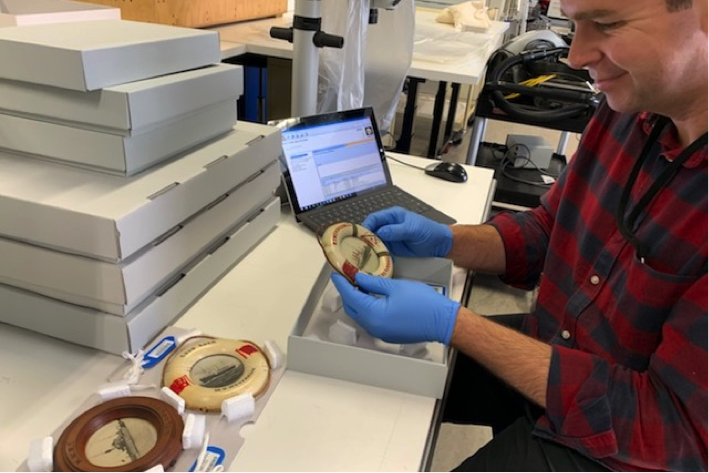
Nick Flood had the good fortune to encounter the second object to be acquired in the National Maritime Collection. This unassuming item, numbered 00000002, is a coloured black and white photograph of the MV AORANGI mounted inside a miniature lifebuoy.
Research
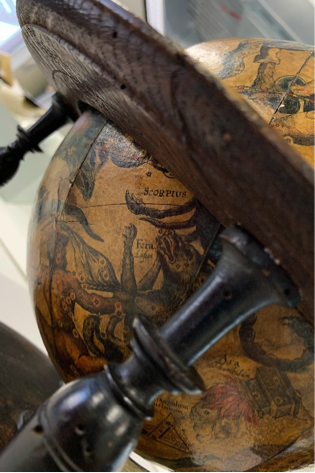
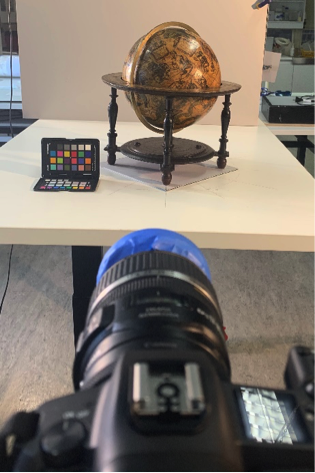

Lucilla Ronai and Katie Wood used a number of methods to investigate a rare 1602 example of a Blaeu celestial globe. They used a variety of light sources to document the globe, including visible light and UV and infrared radiation. Infrared reflectography was particularly successful at showing obscured inscriptions on the globe. Many thanks to Matteo Volonté (ICS) for lending us his infrared equipment. Additionally, a 3D model (virtual) was created using photogrammetry, but more on that next e-News.
Exhibition preparation
Sue Frost and the whole team deinstalled over 80 works at the end of the Gapu-Monuk Saltwater — Journey to Sea Country show. The exhibition featured bark paintings, created by 47 Yolŋu artists who petitioned for sea rights by painting their Sea Countries onto bark and revealing sacred patterns or designs.  Agata Rostek-Robak and Nick Flood travelled south of Sydney to HMAS Albatross to inspect the Seahawk helicopter that will be delivered to the Museum in the coming months. The tiger livery on the tail was used to celebrate the 60th birthday of the Royal Australian Navy’s 816 Squadron in 2008.
Agata Rostek-Robak and Nick Flood travelled south of Sydney to HMAS Albatross to inspect the Seahawk helicopter that will be delivered to the Museum in the coming months. The tiger livery on the tail was used to celebrate the 60th birthday of the Royal Australian Navy’s 816 Squadron in 2008.

Now that On Sharks & Humanity exhibition is in place we have been kept occupied maintaining the artworks, sometimes on a daily basis.
Workshops, symposia and media
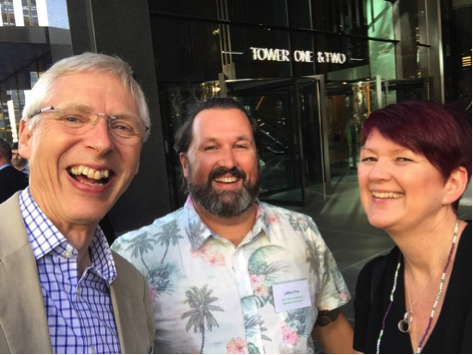
In February, Jeff Fox presented at the ‘Managing Risks to Collections’ symposium on the Museum’s work in changing the environmental conditions is the gallery space.

Conservators and curators combined to publish a blog on the Rusticle live display in the James Cameron—Challenging the Deep exhibition. The ‘Rusticles and wrecks’ blog is well worth a visit for the time-lapse and 3D model alone.
Social News
Jeff Fox, Lucilla Ronai and Nick Flood have been made permanent employees of the Museum after two and a half years on contract. Congratulations to them and to Agata Rostek-Robak for her tireless efforts to have the importance of these three positions recognised. The Museum had its Christmas party with the theme Golden Age of Hollywood. Nick Flood dressed as Humphrey Bogart for the evening.

David Stein
Social
After seeing off 2018 with our Christmas lunch at Nomad, David Stein and Co closed the studio for our Christmas break. After a fantastic year we started our holidays on a somewhat sad note, as Sian Griffiths announced her intentions to leave the team. After 19 years and many thousands of paintings treatments, Sian is taking a well-deserved break from the conservation studio before moving on to greener pastures. Arriving back in the studio in January it seemed strange not to have Sian’s presence as we kick off the new year. We wish her all the very best for the future.
Sandi Mitchell’s beautiful baby girl, born in November 2018 and named Zoe, has recently taken a tour of the studio with her mother.
Professional
The large-scale onsite treatment of St Mary’s Cathedral’s Stations of the Cross, that was in its planning stages at the end of last year, has now become a large-scale studio treatment. The Stations are being removed from the walls with the expert assistance of art handlers TED Australia, and transported to our studio in pairs. The paintings are being treated for old water damage, discoloured varnish and overpaint; their frames cleaned of decades of thick dust and candle smoke; and a new hanging system devised.
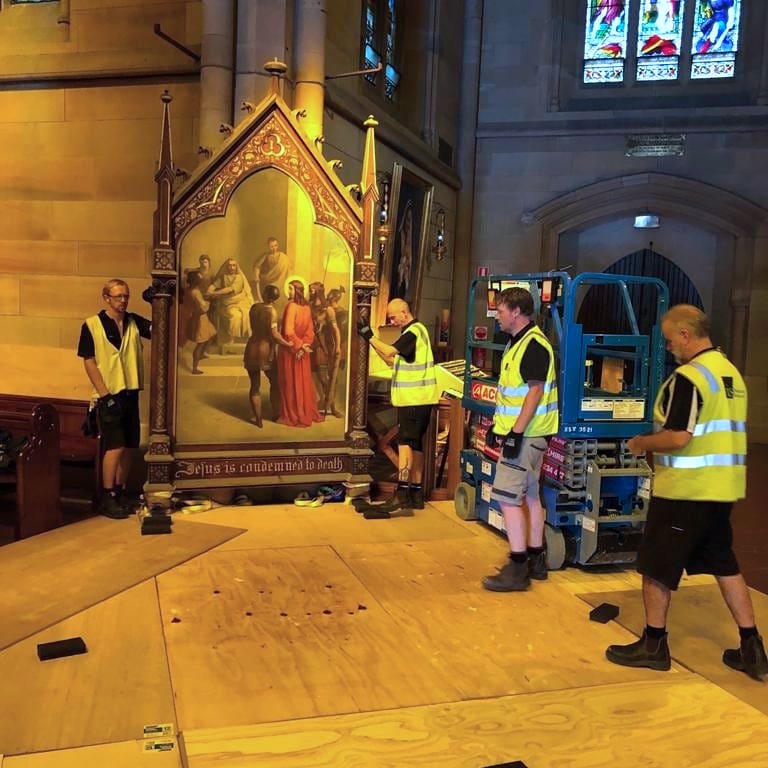 Selina Halim is currently undertaking the treatment of the First Station, which involves surface cleaning, removal of discoloured varnish and extensive previous overpaint, as well as consolidation and necessary cosmetic treatments. Lucy Tedder is working on Station Six, currently removing a natural resin varnish, and looking forward to some extensive overpaint removal. The paintings have been marouflaged onto plywood in the past, and display all sorts of interesting structural and cosmetic issues that will need to be addressed. With Selina and Lucy’s help, two down and twelve to go!
Selina Halim is currently undertaking the treatment of the First Station, which involves surface cleaning, removal of discoloured varnish and extensive previous overpaint, as well as consolidation and necessary cosmetic treatments. Lucy Tedder is working on Station Six, currently removing a natural resin varnish, and looking forward to some extensive overpaint removal. The paintings have been marouflaged onto plywood in the past, and display all sorts of interesting structural and cosmetic issues that will need to be addressed. With Selina and Lucy’s help, two down and twelve to go!
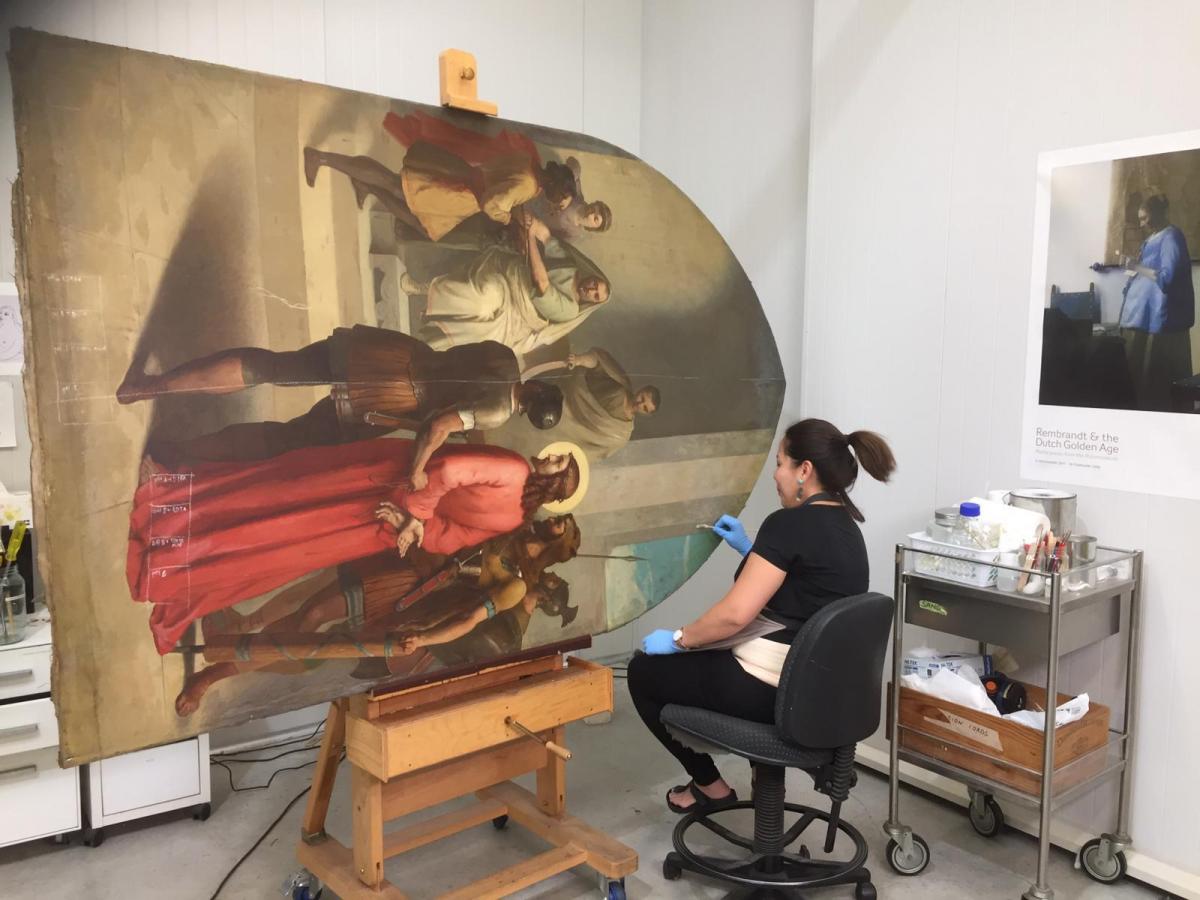
Julia Sharp has recently completed a complex varnish removal on a 17th century Dutch painting on panel, attributed to the circle of Rembrandt. She is continuing her treatment to another 17th century canvas, including pigment analysis in conjunction with Sydney Analytical, which has yielded some promising results. She is currently in the process of preparing the painting for lining, complicated by the presence of a central horizontal seam that has to be accommodated. She is looking forward to attending the lining symposium at Yale in October this year.
Anne Perrin has completed several interesting treatments in recent months, including an early canvas by Tom Roberts which involved consolidation, varnish removal, restretching and retouching; as well as an Ian Fairweather panel, which she consolidated using funori and our hot air pen. She is currently tackling a complex treatment of a large mixed-media artwork by John Wolseley. The work consists of mixed media drawings on paper, which have been adhered to a loose canvas sheet. The use of a humidity chamber and an extendable aluminium stretching frame is being considered, amongst other solutions.
Selina Halim has also worked on a complex cleaning treatment on an Elioth Gruner painting which had a thick layer of dirt, grime, discoloured varnish and overpaint. The treatment required a mixture of aqueous, solvent and xanthan gum gel cleaning solution.
Kim Vernon is wading through a number of confusing media layers on an early 19th century portrait of Napoleon Bonaparte, which has obviously led a full and interesting life. Evidence of charring, water damage and a hidden inscription have been revealed during the treatment process, and he’s not quite finished yet.
David Stein and Katherine Rosenthal recently attended the exhibition opening for Arthur Boyd: Landscape of the Soul at the National Art School in Sydney. Many of the works from the Bundanon Trust Collection moved through our studio for the purposes of conservation treatment and reframing, which was carried out in collaboration with framer June Anderson. David also led a discussion with NAS Gallery Manager and Curator, Judith Blackall, for students at the National Art School, on Arthur Boyd’s materials and techniques and his long history with the Bundanon Trust Collection.

Our Registrar, Soleste Ponticello, attended the ‘Managing Risks to Collections’ symposium in Melbourne in February, and has come back inspired to implement many of the risk management strategies presented within the studio. The team has also hosted an evening tour of our studio for Art Signifikant, a gallery membership program which is an initiative of Michael Reid Gallery in Sydney, aiming to support the flow of art knowledge and experience among collectors. It was a successful and informative evening, as David and the team are always keen to share our knowledge and passion for conservation with a captive audience!
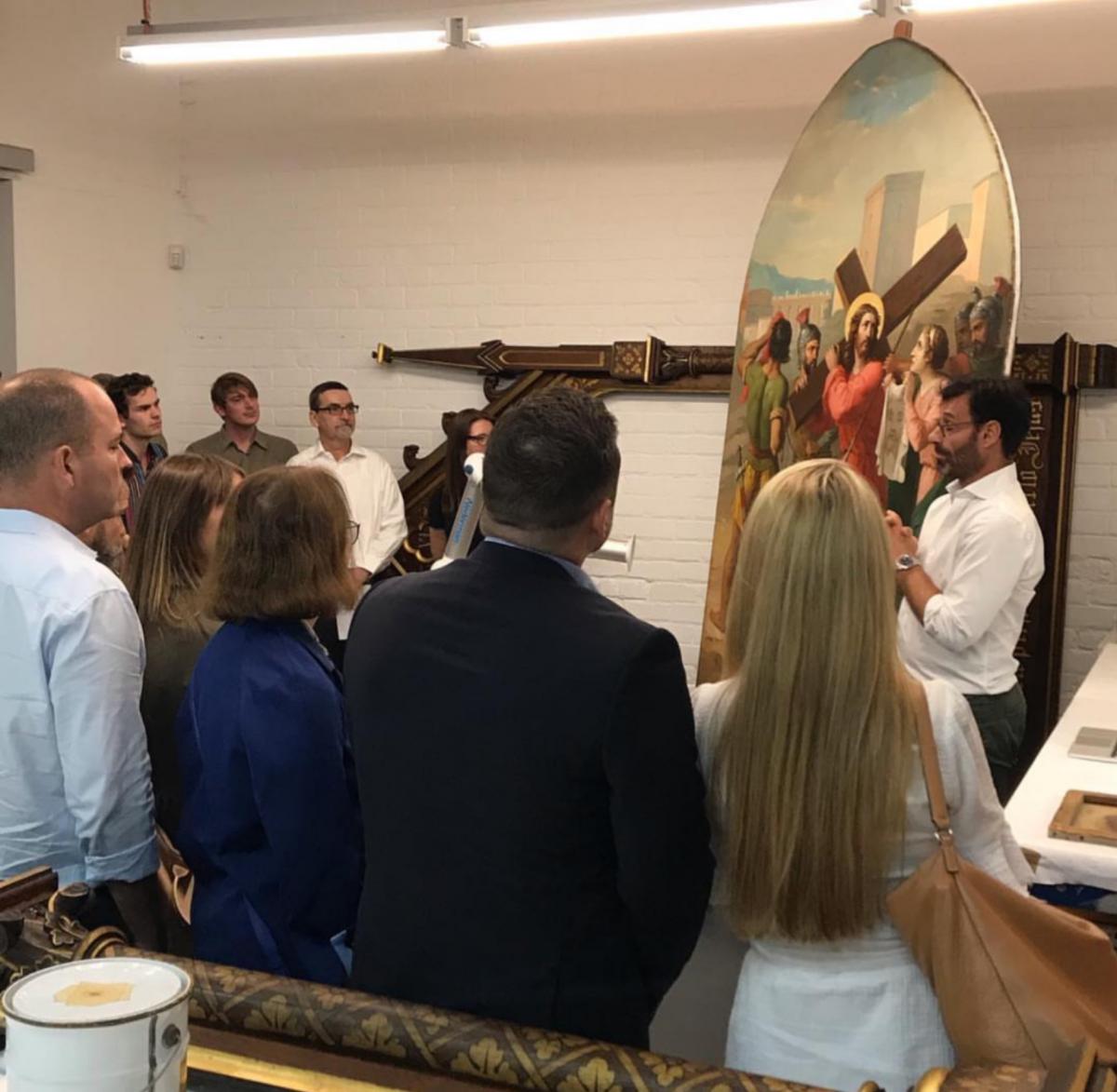
Heights Heritage Conservation
Treatment Projects and Exhibitions
The majority of this quarter has been taken up with the organisation of the Textile Special Interest Group Symposium, but Tess Evans, assisted by Hannah Evans, completed the removal and packing of the very large (23m x 2.5m) Mona Hessing ‘Banner’ tapestry, hanging from the foyer of the Clancy auditorium at UNSW, in preparation for major building works being carried out over the next six months. The tapestry will be cleaned and a new hanging system developed in the interim, with reinstallation later this year.
Working with the City of Sydney, Tess is preparing and installing an artwork called ‘Guruwin Shark Net’ by Nadeena Dixon, which will hang in the front foyer of the City’s new depot in Alexandria, Sydney, from March.
Tess is also mounting changeover textiles for the Marion Hall Best: Interiors exhibition for Sydney Living Museums in preparation for its next tour starting in March.
A very successful symposium was held at the Sydney Jewish Museum, with two days of interesting papers and talks from local and international speakers. Dinah Eastop, as keynote speaker, presented two fascinating papers and three interactive workshops, making us all think a little more deeply at our practice. Highlights were the wonderful breakout session by postural physiotherapist Sally Harrison from Perfect Form Physiotherapy, whose energy and enthusiasm was infectious, and challenged us to keep moving, and the following fabulous tours.
The opening reception was held at the Anzac Memorial in Hyde Park with a wonderful introduction and private viewing of the exhibition hosted by curator Bradley Manera. The afternoon of day two was a tour of the Sydney Jewish Museum, Holocaust Exhibition, archives and a very special presentation of the temporary exhibition by the artist Sylvia Griffin of The Fate of Things: Memory Objects and Art, where she explained her artist intent through inherited objects, remnants and relics, remembering her family’s Holocaust experiences. It was very powerful.
And finally, on day three, delegates chose to either visit the MAAS to see various exhibitions or to travel to the Museum Discovery Centre to see the MAAS textile storage areas. Thank you so much to the MAAS team of Suzanne Chee, Kate Chidlow and Bronwyn Dunn for a great tour.
As coordinator of the TSIG, Tess would like to thank all those who helped over the two days and especially our sponsors: Archival Survival, Rax and Dollies, Pickwick Framing, Australian Plastic Fabricators, Heights Heritage Conservation and Sophie Brown Conservation Framing, who supplied two beautiful frames as gifts for our two special presenters.
Social News
On January 27th Tess completed her goal swim with Can Too, swimming 2.8km (plus 500m due to surf conditions) from Palm Beach to Whale Beach, raising $1,500 for cancer research. As probably the hardest adventure she has had to face as a non-swimmer—taking over two hours and with swells of 4ft and water temp of 19degs, causing sea sickness and cramps—it was a very challenging swim indeed.
International Conservation Services
Barangaroo boat, Sydney
If you remember from the last AICCM Newsletter, we had the privilege to work with archaeologists to lift and remove a marine relic at Baranagroo. Before we left for the Christmas holidays the Object and Outdoor Heritage team finally finished the removal of the boat from the construction site. The boat has been carefully removed, documented, packaged and transported.
Nolan’s ‘Eureka Stockade’
We always enjoy the challenge of complex conservation projects, many of which include physical relocation. The latest has been the relocation of Sidney Nolan’s Eureka Stockade mural from the Reserve Bank of Australia’s Melbourne office in Collins Street to the new Kambri Centre at ANU in Canberra. This mammoth work on 66 panels of enamelised copper is the only major work that Nolan undertook in this medium. Commissioned by Dr Nugget Coombs when he was Governor of the Reserve Bank, its relocation has a nice synergy as Coombs was also Chancellor of ANU. Our challenge was to remove it from the wall in Collins Street, from which it was clearly never meant to be taken down, and develop a new hanging system that not only ensured alignment but also allowed for further relocation at some stage in the future. Lauren Keating, Kristine Allinson and Bronwyn Tulloh oversaw the cleaning and preparation in Melbourne, and Doug Rogan managed the installation in Canberra, which was undertaken very capably by Abode Restorations.

State Theatre, Butterfly Room
We are now in the final stages of conserving and restoring the Butterfly Room at the State Theatre. Matteo Volonté, Suati Rojas and Jochen Letsch went to site last week to install the last decorated panel. The panel was lined onto synthetic canvas and laid on aluminium composite sheet before re-installing. The Butterfly Room had a number of issues relating to past water damage, particularly along the wall where the last panel stands. The wall had been previously lined to prevent salts entering through the wall onto the panel. The new aluminium lining on the panel protects it from water penetration and also allows the panel to be easily de-installed if any further problems re-occur.


Mould
Paper has been incredibly busy working on wave upon wave of mould remediation work. Wendi Powell and Jennifer Todd have recently come back from North Queensland, where they spent a week removing mould from a large book collection. Over the next month, the team will be working on many book mould and rehousing projects. Mould is clearly blooming!
Staff News
We are delighted to welcome a number of new staff to ICS, some filling established roles and some undertaking new ones. Dr Wendy Reade joins us as Senior Conservation Projects Manager, building on a distinguished teaching, research and conservation career most lately at the University of Sydney. Christina Ritschel joins us from the V&A in London as Senior Textiles Conservator. Christina is well known in Australia from a previous position she held at the NGV. Finally, our two new Conservation Technicians are Kirwan Williams, who has a background in archaeology, and Jochen Letsch (Conservation Technician and Frames Specialist), who brings with him a wealth of experience from his previous life running the ASA conservation framing business. Lauren Keating, our Objects Conservator in Melbourne, is sadly leaving the team to pursue a new career. We wish her luck with her new endeavour.
Museum of Applied Art and Sciences (MAAS)
Trish Stokes, our new Conservation Manager, has been warmly welcomed. MAAS has also been involved in CARnivale 2019 in Parramatta on January 26th. Bronwyn Dunn co-ordinated the delivery of the two vintage cars from the MAAS Collection—an Austin Seven and an Australian Six—which were transported from the Museum Discovery Centre to North Parramatta, much to the joy and appreciation of car enthusiasts attending.
Suzanne Chee presented a paper at the AICCM Textile Special Interest Group (TSIG) 4–5 February, ‘Fibre, Fur, Feather and Finishes’, entitled ‘3D fashion—the download’. Frances Fitzpatrick and Megan Hall also attended. The conservation department also gave two tours. Bronwyn and Kate Chidlow provided a tour of the MDC textile storage areas. Viewing our rolled textile project, lace re-housing, cold storage areas, AIDS quilts and Olympic collection areas. Suzanne gave a tour of the textile-centred exhibitions at the MAAS Powerhouse Museum such as Akira Isogawa, 40 Years of Fabulousness and Good Design Awards 2018: Fashion Revolution Australia. Bronwyn Cosgrove (ARC PhD student) spent two days after this conference undertaking some further FTIR analysis of MAAS textile sequin collection.
Sue Gatenby attended and presented at the IRUG (Infra-red and Raman Users Group) 13, on the 5–7 December 2019 at the Art Gallery of NSW, presenting ‘Assessment of chemical ageing of cellulose acetate’,which was a collaborative research project with the Getty Conservation Institute. Megan and Rebecca Ellis also attended the conference. After this conference we hosted three PhD students: Bronwyn Cosgrove, Julianne Bell and Cancy Chu from the University of Melbourne, ARC – ‘A National Framework for Managing Malignant Plastics in Museums Collections. These students undertook collection research 11–13 December 2019 and interviewed many staff members.
The quarterly ARC project meeting was held at MAAS on the 4 December 2019. Attending institutions: MAAS, UTS, Uni of Melbourne, ART Gallery and UTS.
Su-Yen, Director of Registration and Conservation, and Gian-Ton, Conservator from the National Place Museum, Taiwan, visited the lab and spoke with Sue about conservation environmental issues.
The three sealed Tibetan buddhas have been returned from ANSTO with the images of their contents.
The first stage of research investigating the hazing/fogging of showcase glass has been completed with Raman analysis carried out by Sydney Analytical, University of Sydney. This stage has identified the chemical composition of the residues on the glass. Stage 2 will look at methods of preventing the development of the glass hazing.
Outward loans
Bronwyn has been busy preparing 74 objects for a loan to the MCA for the Janet Laurence: After Nature exhibition, comprised largely of eucalyptus oils, botanical specimens and 19th century botanical models. It was great to have the opportunity to work on this rarely accessed collection.
Exhibition openings: Star Wars Identities and Akira Isogawa.
Exhibitions dismantled: Human non Human, Design Nation, Common Good and Spinning World.
A blog has been written by the conservators who worked on the Reflections of Asia exhibition with case studies of the treatment of several objects on display.
Kate and Suzanne have been developing a handout on how to make Fosshape mannequins. An invaluable resource for those of us who would like to make mannequins for display, quickly and easily, for very little cost.
The Australian Dress Register (ADR) is about to be relaunched. The ADR it is a collaborative online project about dress with Australian provenance. This includes men’s, women’s and children’s clothing from the special occasion to the everyday. Museums and private collectors are encouraged to research their garments and share the stories and photos online. Please contact Kate or the ADR team if you would be interested in finding out more about the ADR.
The relocation project is underway. Initially the conservation labs will be reorganised to make room for the new remembers of staff. 14 hot desks will be set up and more working lab space created. There will be several conservation positions advertised for this project over the coming months.
State Library of New South Wales
Social
In the Collection Care Digital Excellence (DEP) Team, Natalie Cassaniti has recently returned from a three-month temporary contract at the ABC as a preservation officer. Welcome back Natalie and thank you to Silvana Volpato who back filled Natalie’s position in the team in her absence.
Treatment projects
The DEP team have finally finished treating the Angus and Robertson correspondence collection in preparation for digitisation. This collection of correspondence from the publishers (Angus & Robertson) to authors provided the DEP team with hours of juicy reading, our favourites being the many wittily crafted “rejection letters” from the publishers to the aspiring authors. For example:
Dear Sir,
No, you may not send us your verses, and we will not give you the
name of another publisher. We hate no rival publisher sufficiently
to ask you to inflict them on him. The specimen poem is simply awful.
In fact, we have never seen worse.
Yours faithfully,
ANGUS & ROBERTSON LTD.
The work involved well over 3000 tear repairs as well as a variety of other treatments.
Paper conservation treatment is about to commence on A Journal of the proceedings of His Majesty’s Bark Endeavour on a voyage round the world, by Lieutenant James Cook, Commander, commencing the 25th of May 1768 – 23 Oct. 1770 (SAFE 1/71). This is a copy of Cook’s journal of the Endeavour voyage copied out on the voyage by his clerk Richard Orton. This major treatment is preparation for the Library’s Cook programming in 2020.
Conference attendance
Jonathan London, Catherine Thomson, Felicity Corkill, Helen Casey, and Hoa Huynh will be attending the upcoming “Managing Risks to Collections” conference in Melbourne in February. At the conference Hoa will be presenting a paper on UV glazing for artworks.
SA
Artlab
Conference Attendance
Kristin Phillips and Mary-Anne Gooden have just returned from attending two and a half fabulous days at TSIG in Sydney. A big thankyou to convenor Tess Evans for organising such a great event!
Treatment projects
Kristin Phillips has been in Penang for three weeks in early February to begin the project to undertake the conservation of the Nine Emperors Banner at the Kew Ong Yeh Temple in George Town, Malaysia (Image 1). The banner has been at the temple for nearly 120 years. The recent project follows on from a training workshop for the local community undertaken in December 2017. In this latest stage Kristin worked with the conservators at George Town World Heritage Inc (GTWHI), Annie Lee and Miki Tempo, and a group of volunteers to conserve the banner. The banner was dis-assembled and the fragile embroidered silk will be stitched onto a new lining. The group will carry out the stitching of the loose gold thread and damaged silk. On her return in July Kristin will work with the team to re-assemble the banner and install it in a purpose-built display case where it will continue to be displayed in the temple.
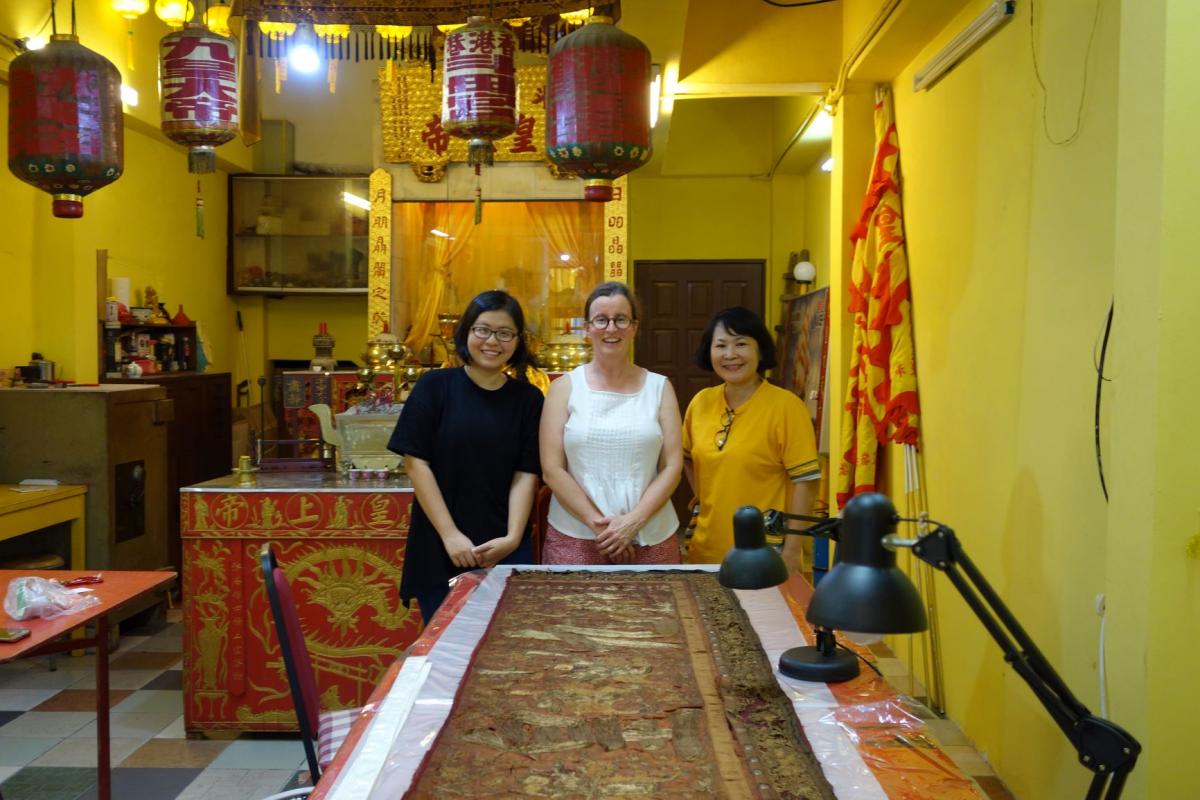
Back in Adelaide, the display of a 1950s diving suit for South Australian Maritime Museum’s Lustre exhibition presented the Textiles team of Kristin Phillips and Mary-Anne Gooden with a few challenges. The suit arrived to us with an internal support/mount consisting of several wooden fenceposts that had been ‘sensitively’ inserted amd screwed together inside the item to provide ‘shape’ to the suit in its pre-museum life. One of the challenges with this object has been the restricted internal access, which was limited to the top opening at the neck. With the help of Objects Conservator Justin Gare & his chisel, the wooden posts were removed. Interestingly, the extrication also revealed several pairs of early/mid twentieth century men’s woollen long-johns (with fabulous makers’ labels still attached!) and knitted jumpers that had been stuffed inside the arms & legs of the suit.

To replace the fenceposts, and give the dive suit a more realistic internal body-like form, a Fosshape form was made. A plastic male mannequin was used as the foundation for casting the Fosshape enabling us to create a body that could be dissected vertically and inserted through the narrow neck hole of the dive suit in segments. The Fosshape body parts (two feet, two legs and two torso halves) were covered with stockings or stretch knit and stuffed with carved Ethafoam discs and pool noodles to provide greater rigidity. Velcro was used to join the legs and the torso halves whilst magnets were used to align and attach the Fosshape feet to the ankles. Long lengths of cotton tape were also secured to the heels and tied to the neck opening to enable their easy removal if needed.

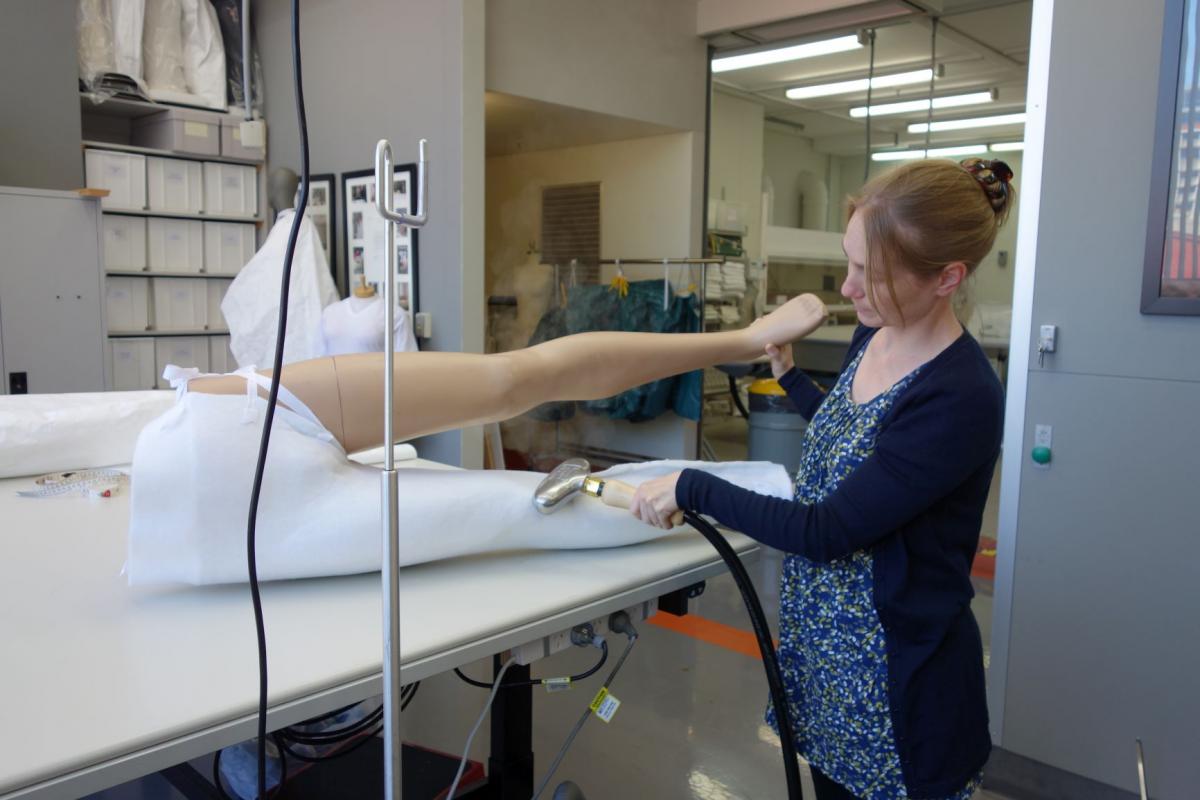
A custom shoulder mount, made by Greg Healey of ghdesign, was fitted within the shoulder cavity and secured to the collar. This has enabled the suit to be supported safely and securely suspended for both display and storage.
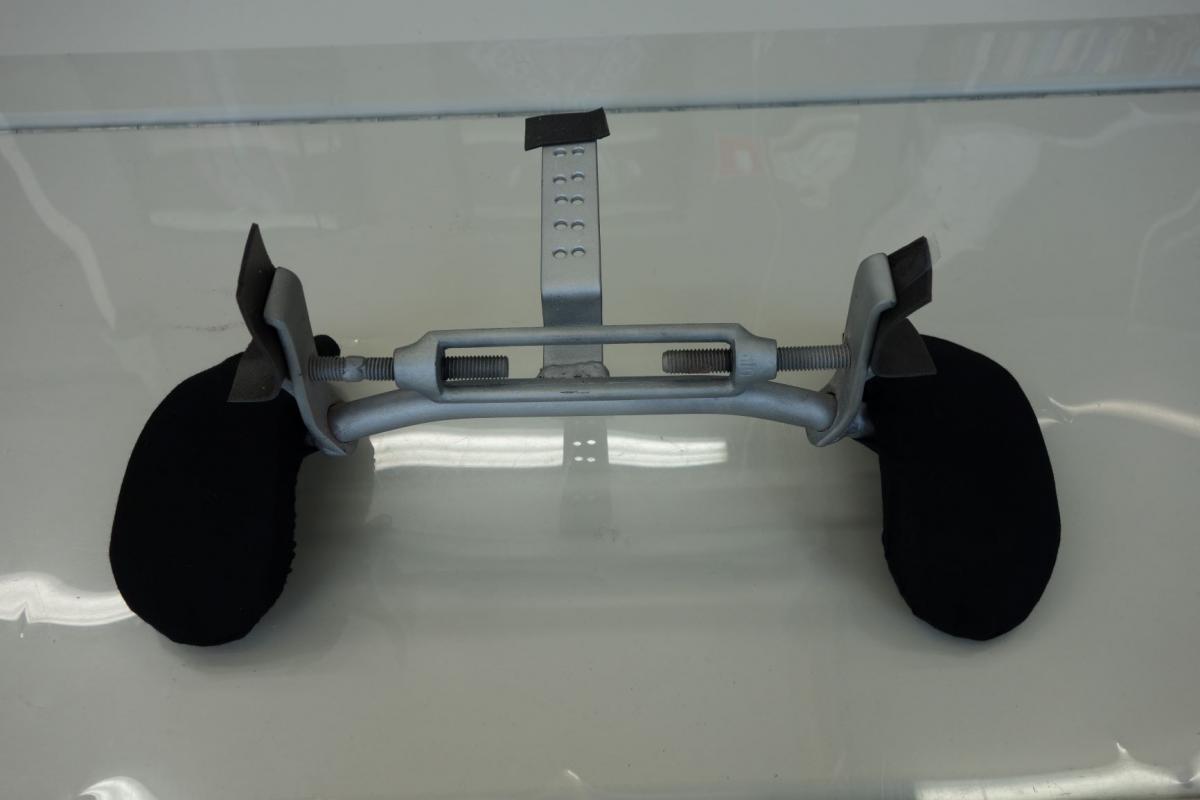
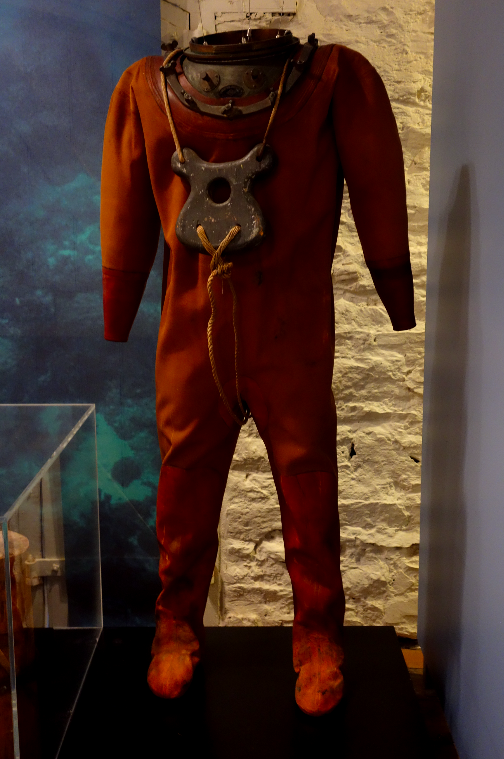
Justin Gare has made a revised version of the portable sloped working table for textile conservator Kristin Phillips for the conservation of the Nine Emperors banner at the Kew Ong Yeh Temple, in Penang (see details of that project above). The table can fold down to a flat pack and requires no screws or fasteners. The angle can be easily adjusted according to the nature of the work and the conservator. It sports a padded elbow rest in the most up-to-date fashionable colour that mitigates contact of the conservator’s grubby forearm with the textile.

The textile can be rolled back under as the work progresses along the length of the textile, thereby reducing the risk of dropping morsels of kway teow or spilling hot chai tea on the ancient fabric.
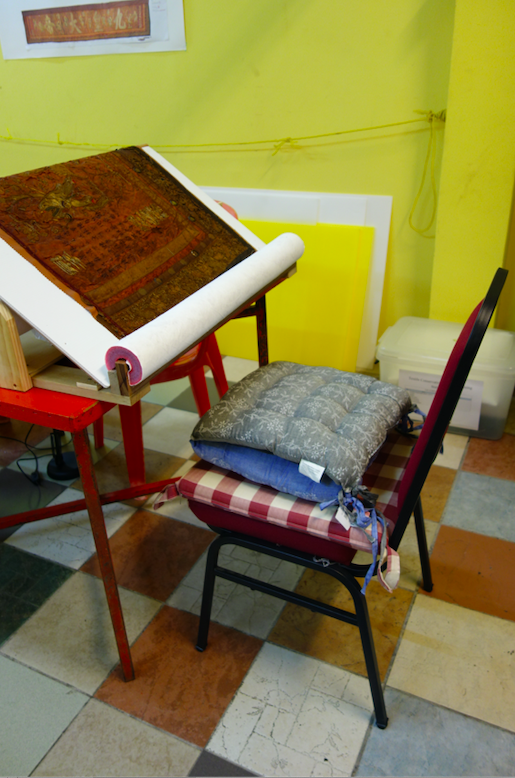
Ian Miles continues his work with the Blackwood War Memorial, much of which currently occupies the Artlab Loading Bay. Meanwhile Abby Maxwell-Bowen is out in the field, assisting Salisbury Council with their artwork inventory and conservation assessment needs. Ranging from traditional plaques and bronzes, murals and mosaics, to more bush-themed settings, the challenges so far have also included tracking down elusive and AWOL artworks from clues on the ground, as well as identifying their makers/artists.
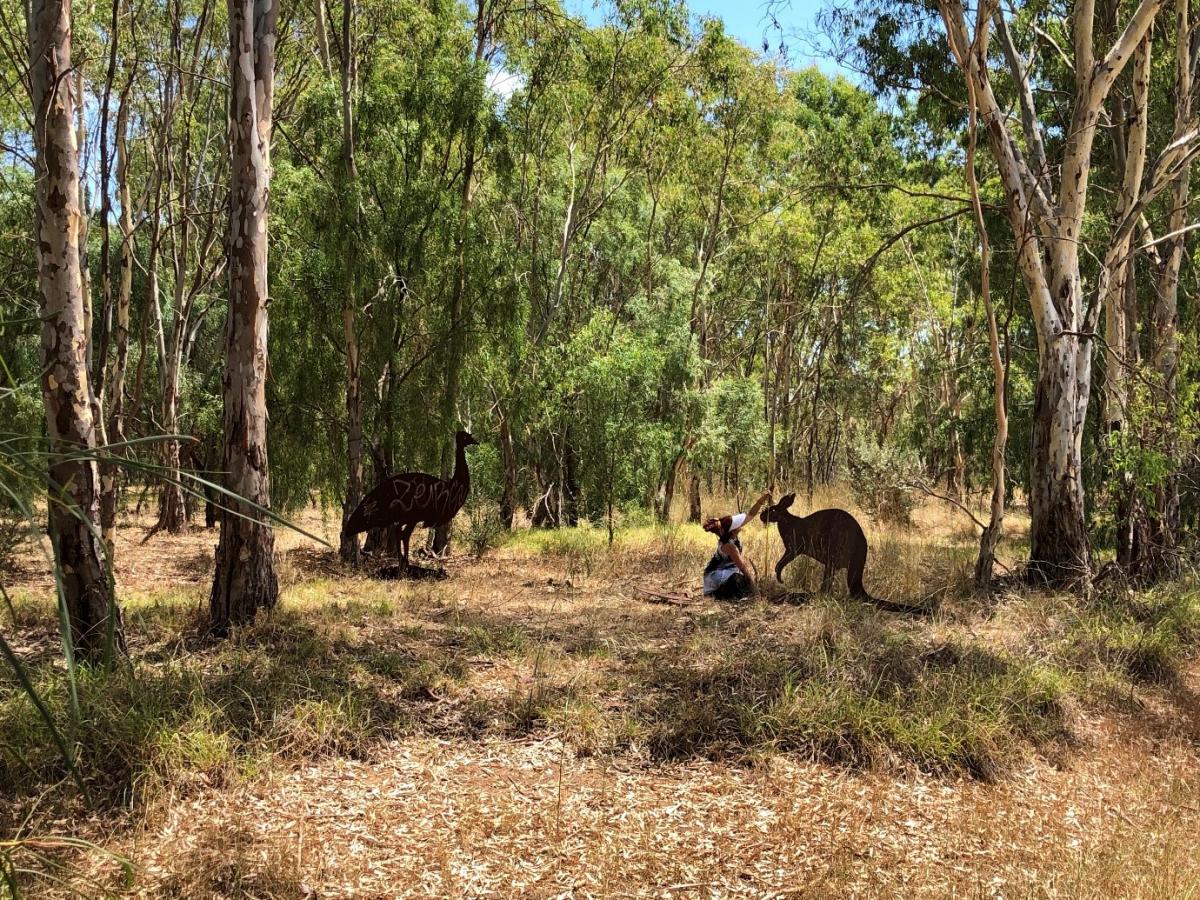
Research and treatment project—A Fan and a Royal Mystery
Desiree Rinne, student at the University of Applied Science and Arts (HAWK) of Hildesheim (Germany), has joined the Paper and Books laboratory at Artlab Australia, for a four-month internship that is due to end this month.
Desiree has conducted a challenging conservation treatment of a privately owned fan believed to once belong to Eugénie de Montijo (1826–1920), last empress of France and wife of Napoleon III.

The fan is entirely hand painted and it consists of two paper leaves, 20 carved ivory sticks as well as two guards held together by a rivet with a semi-precious stone. The semi-precious stone was identified as quartz by Mr. Ben McHenry, Senior Collection Manager of Earth Sciences at the South Australian Museum.
For the last 60 years the fan has been kept in a frame, mounted on a red fabric lined board, but the fan was in poor mechanical condition with obvious old retouching, infillings and reinforcements done with both paper and adhesive tape. The leaves were very fragile especially along the edges where delamination of the painting was present.
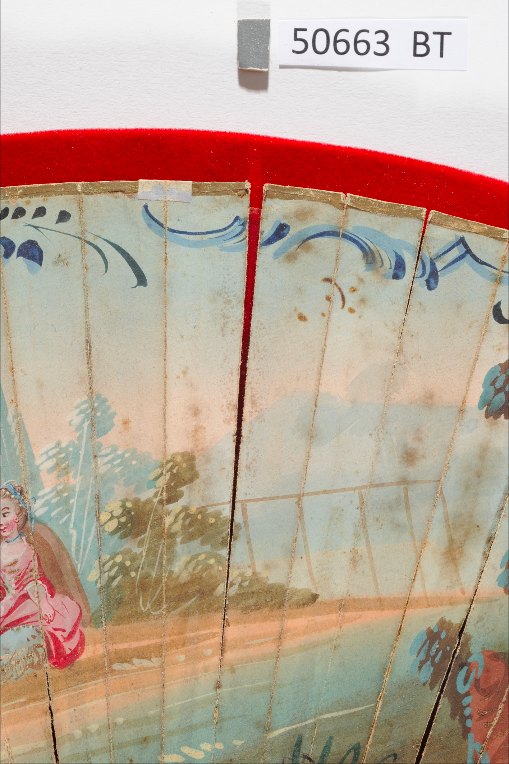
Before commencing treatment, non-destructive analysis of the fan was undertaken in order to gain insights into its physical condition, but it also revealed exciting discoveries regarding its history.
By using infrared imaging, it was possible to visualise the preparation drawing of the group of people painted on the recto, which was made up of dotted lines. Previously retouched areas, old repairs and the original internal structure of the fan became visible too.
The IR analysis shows clearly where the old repairs are present. Due to a discrepancy in the substrate structure, the original paper has laid lines that are not present in the one used for the repairs. A hidden and totally unexpected feature was revealed on one of the old repairs, a modern stamp showing a phone number and an address ‘telephone 219:18 – tel*****c address ** **rnal**’.
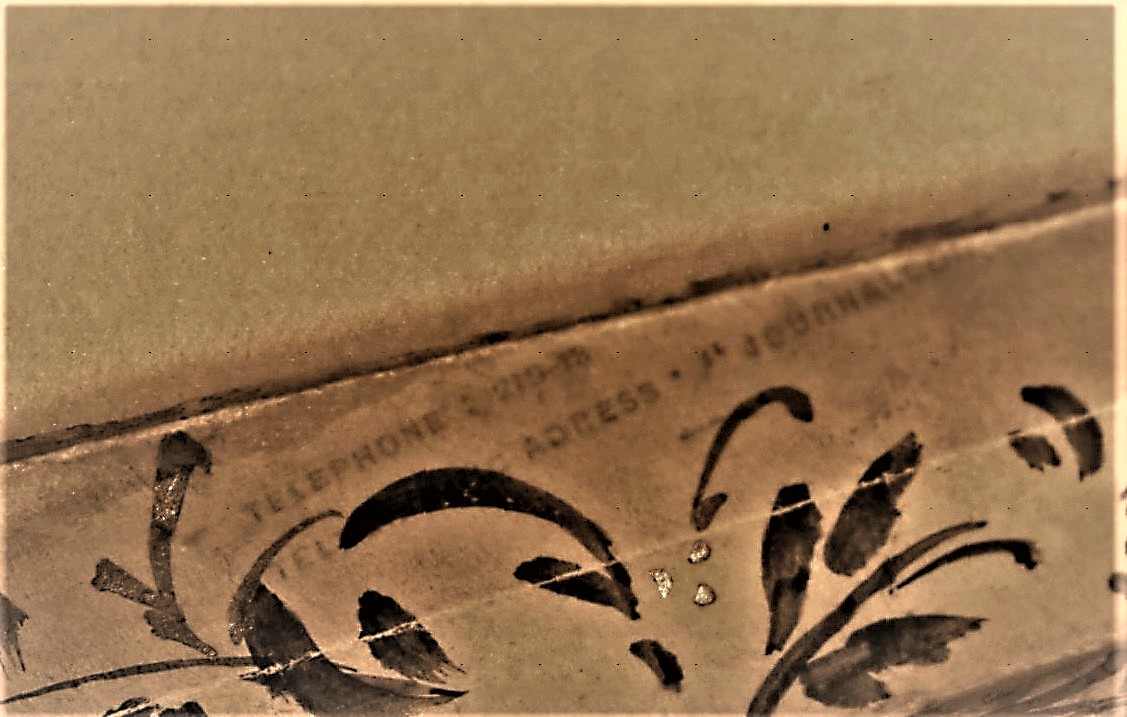
After removing the fan from its mounting board, images of the verso were captured, and a handwritten text became visible. It is on the original part of the fan and a palaeographic study will help in deciphering its content.

There is no painted decoration present on the back of the ivory sticks and superficial dirt could be safely removed by carefully rolling lightly water-moistened cotton buds. On the guard, painted areas were tested for water solubility and found to be colourfast, hence the same cleaning method was used. Solubility tests performed on the painted areas of the ivory came out positive, so the use of moisture was limited to the unpainted parts of the ivory and dry cleaning for the painted ones. The paper was cleaned using soft brushes and by gently rolling small portions of a chemical sponge over the surface while adhesive residues were reduced using organic solvents.
To stabilise the tears minimising the visual impact of the repairs a thin Japanese paper was adhered between the two layers of papers that compose the fan using wheat starch paste.
The finished fan was then reattached to its original board using a thin colour matching cotton string and then repositioned in its original frame.
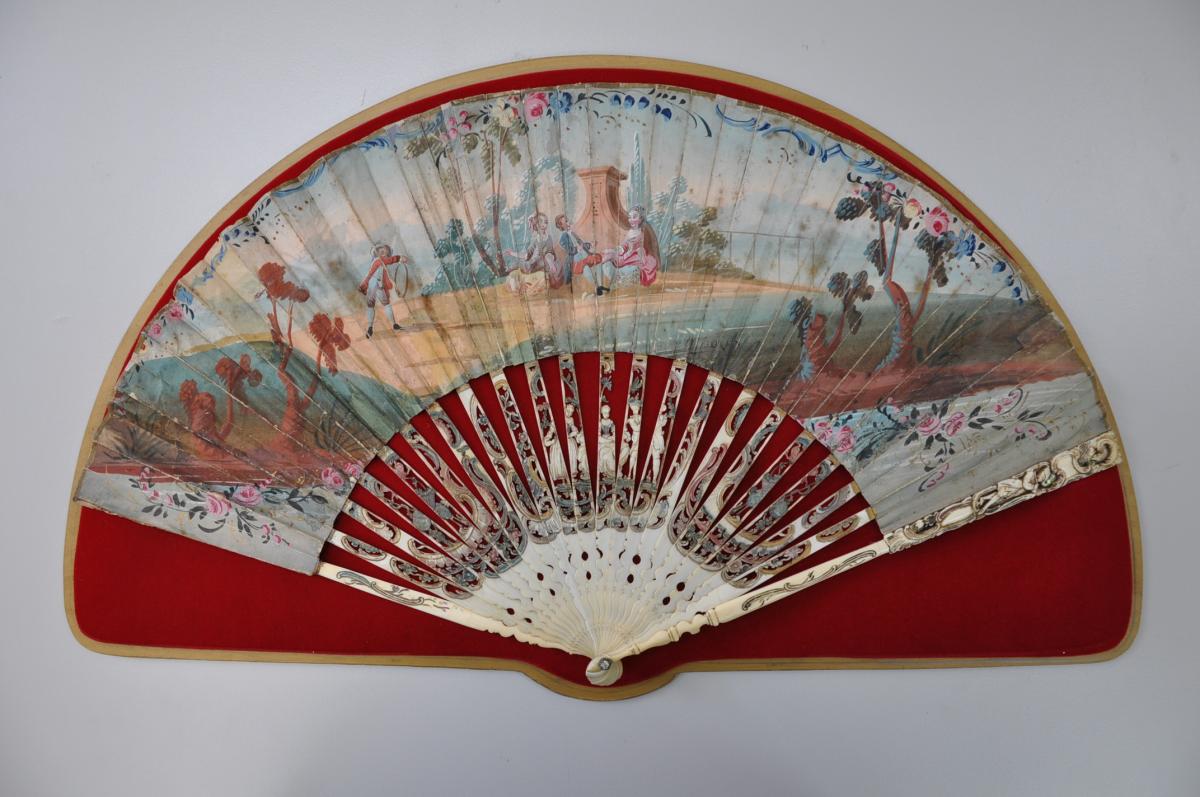
Meanwhile, in the Paintings lab, Rita Costabile has been thoroughly occupied preparing works for the NGV Hans and Nora Heysen exhibition opening in March. Eugene Taddeo and Rosie Heysen have been busy condition checking for the AGSA touring Ben Quilty exhibition. Marek Pacyna and Rosie Heysen have been cleaning several paintings and frames damaged in the Carrick Hill house fire of 1958, removing 60 years of imbibed soot and grime with very satisfying results. Quite a heady smell is released during the cleaning that reminds you of a cross between an old nicotine-stained smoker’s jacket and a Bunnings sausage sizzle!
Image 15: Successful cleaning of fire damage on a gilded frame
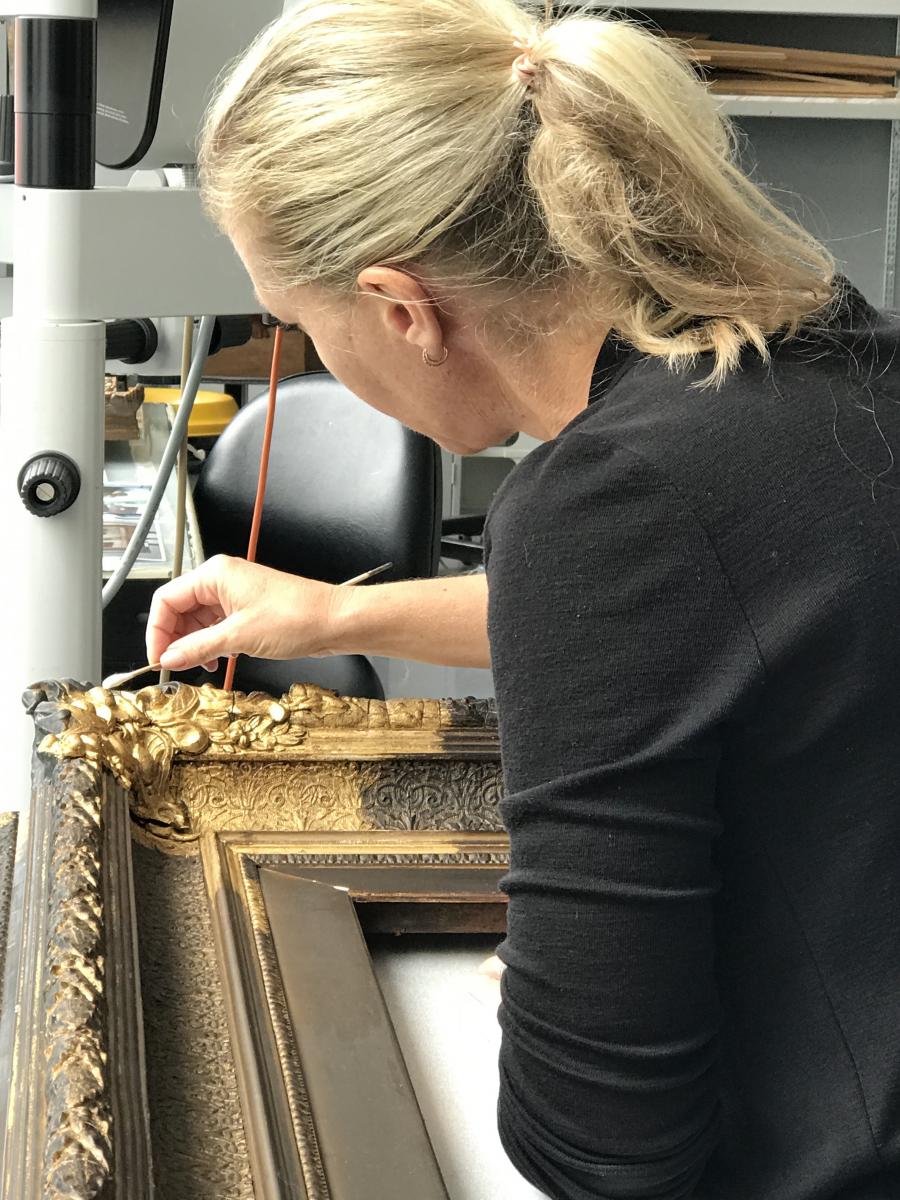 TAS
TAS
Libraries and Archives Tasmania
We have a new name. Our conservation section is now within Government Archives, Preservation and Storage and the organisation is now called Libraries Tasmania and Archives Tasmania rather than “LINC”.
Staffing
Unfortunately, Parisa Yazdekhasty has finished working in Conservation. She was working on a special project dealing with the backlog of re-housing glass plate material, cleaning, protecting, listing and packing out boxes of collections that are on the Digitisation plan. We hope to have Parisa back when we have more funds.
Treatment projects
Stephanie McDonald is treating nearly 40 lantern slides, which have been bound top and bottom with masking tape. These are to be digitised and the tape has obscured the image in some instances and the adhesive has oozed causing the plates to adhere to each other. They will be photographed to capture inscriptionsbefore the tape removed, the glass cleaned and they are re-bound with archival gummed paper tape.
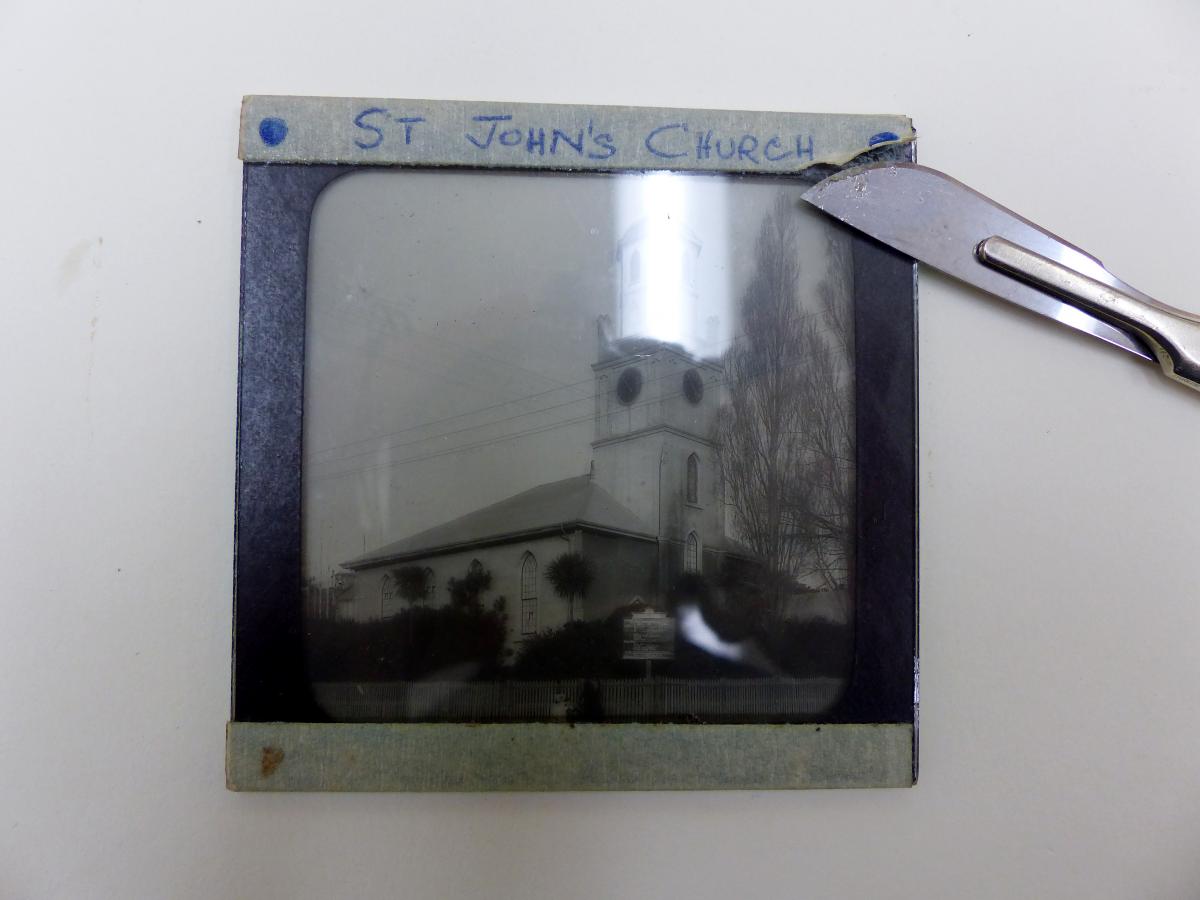
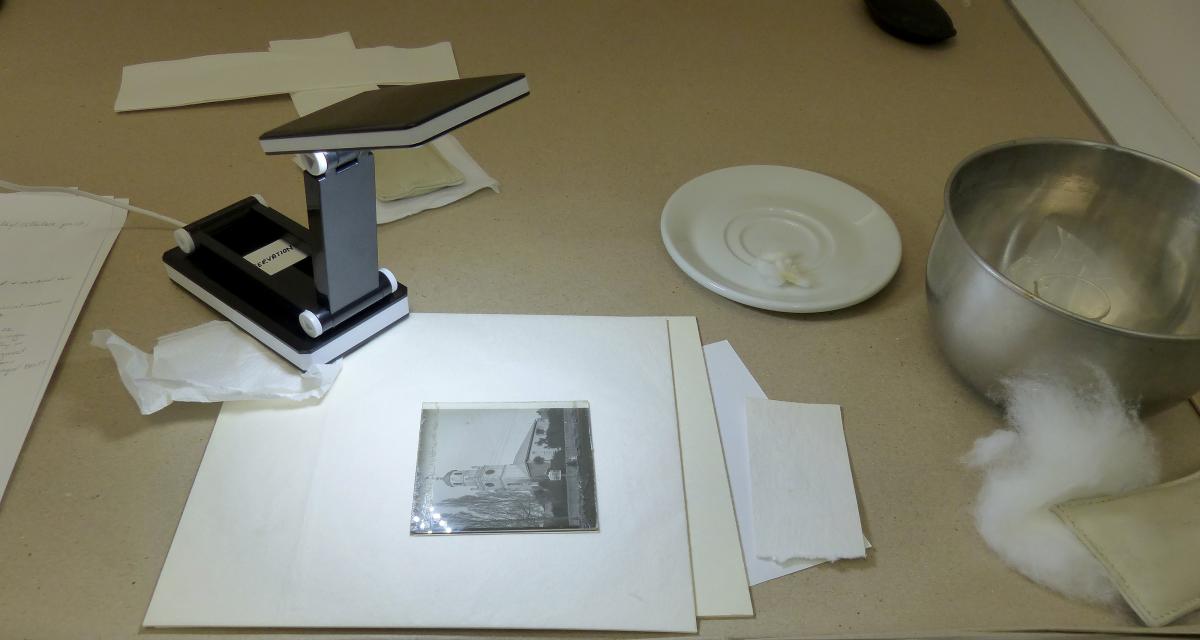
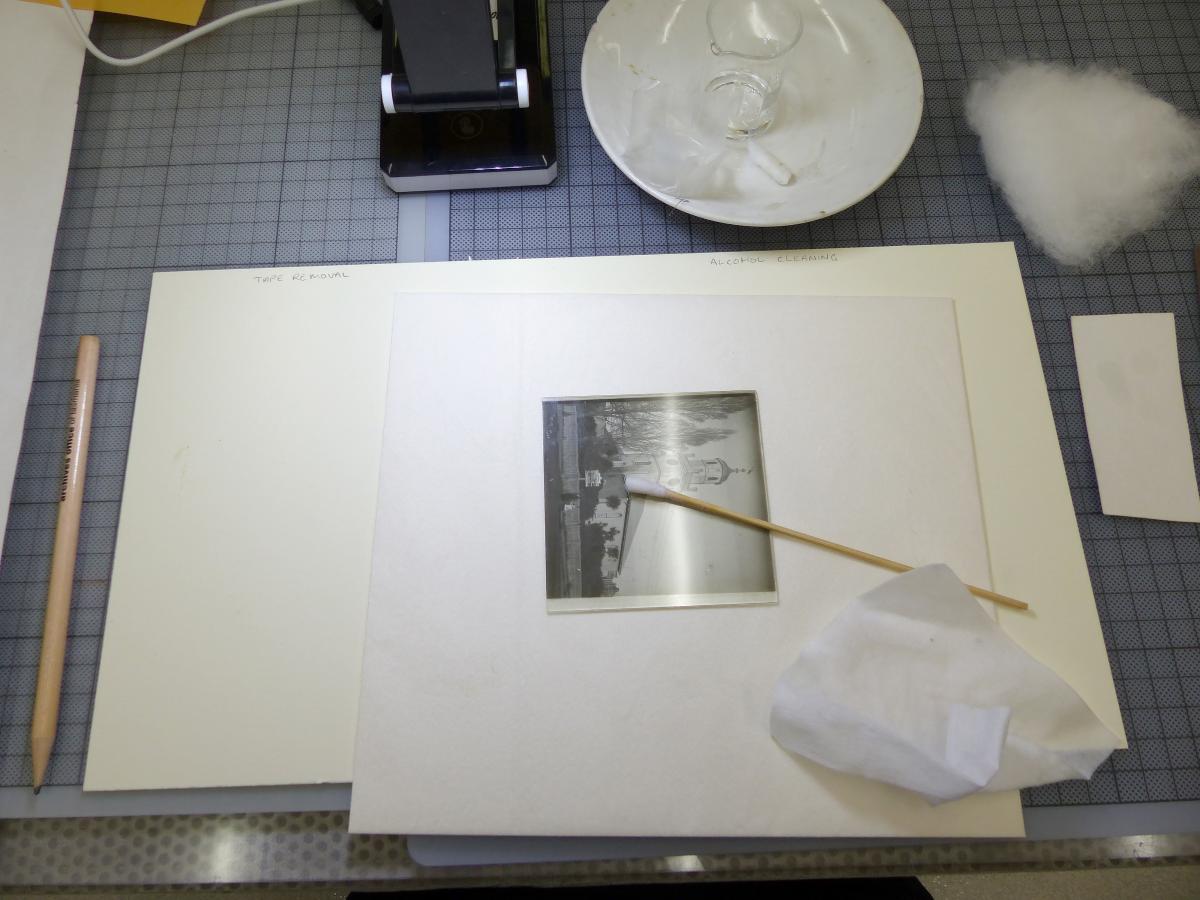
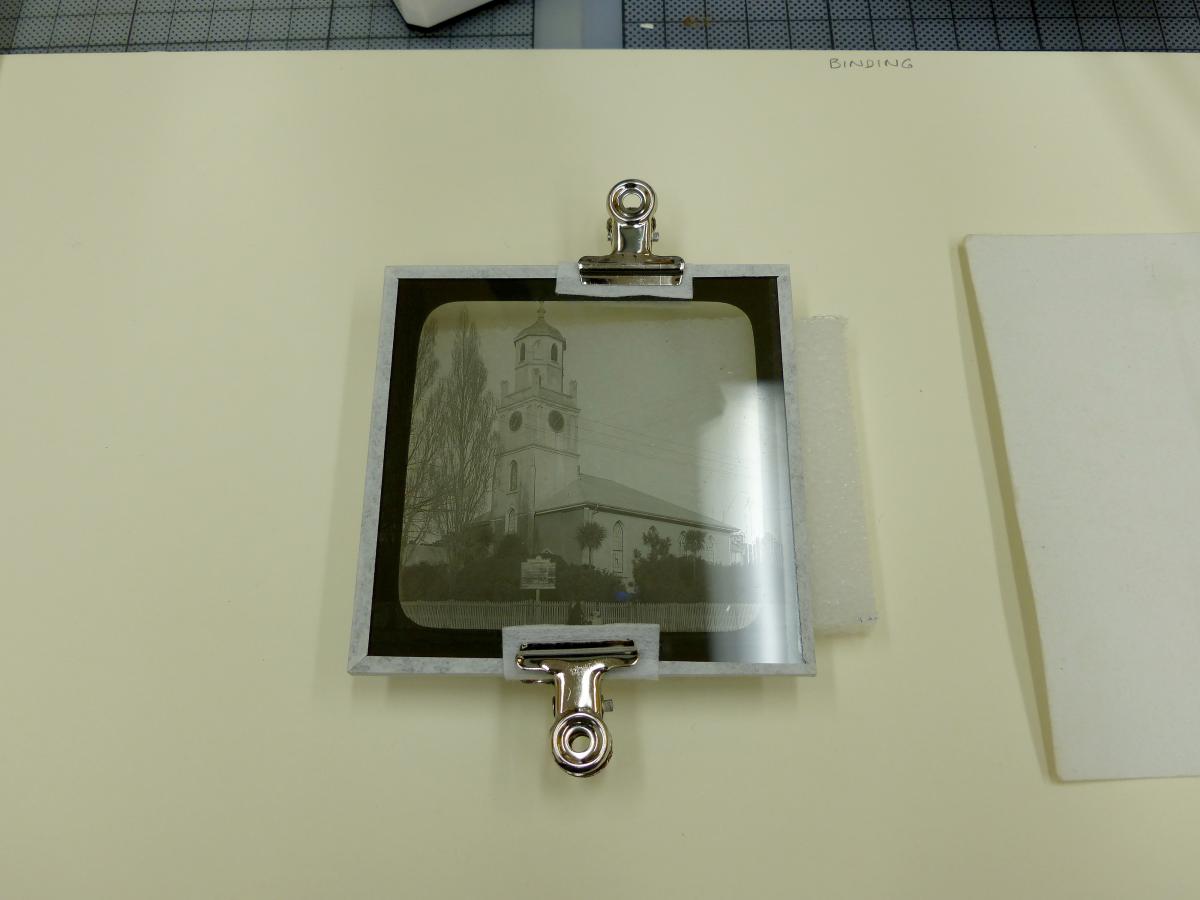
Stephanie has also been assisting staff with access to fragile items such as mould-affected burial records for the Anglican Church and diaries for the Narryna house museum.
Conservation Officer, Gaynor Tollard has cleaned mould-affected volumes from the Archives collection and continues to invent new designs of custom boxes for some of our more fragile items such as this opalotype from the Ash Bester photographic collection.
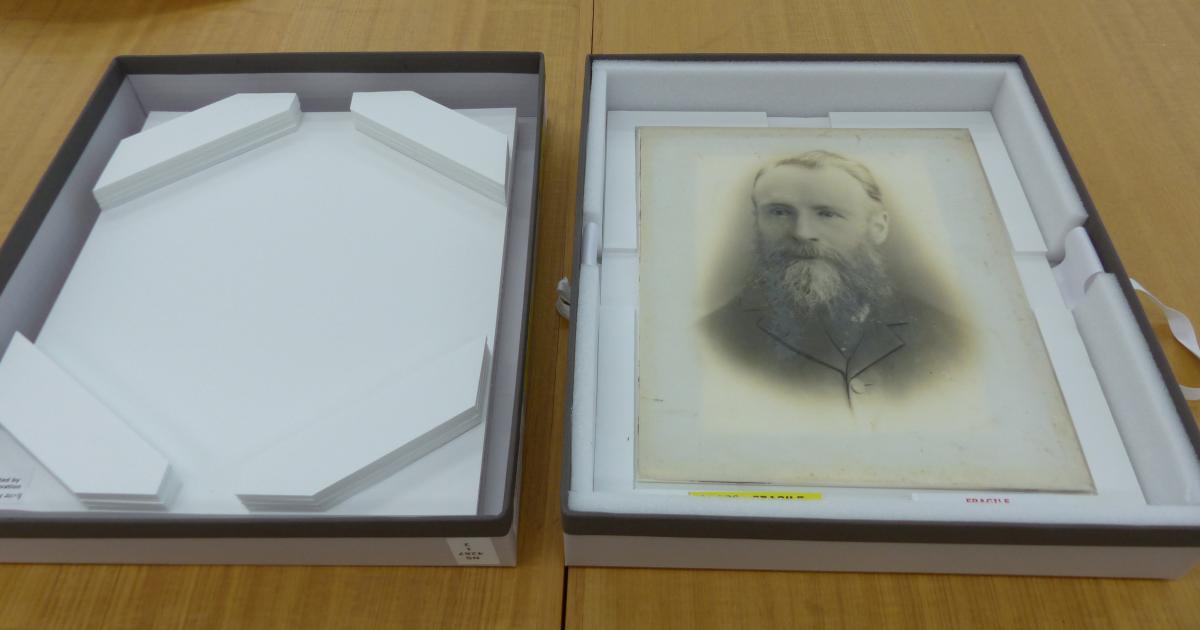
Gaynor has been helping Julie Kaja, Collections Technician, to set up new collection handling trolleys in our stack areas and secure viewing room and will follow up with handling training for our access and retrieval staff.
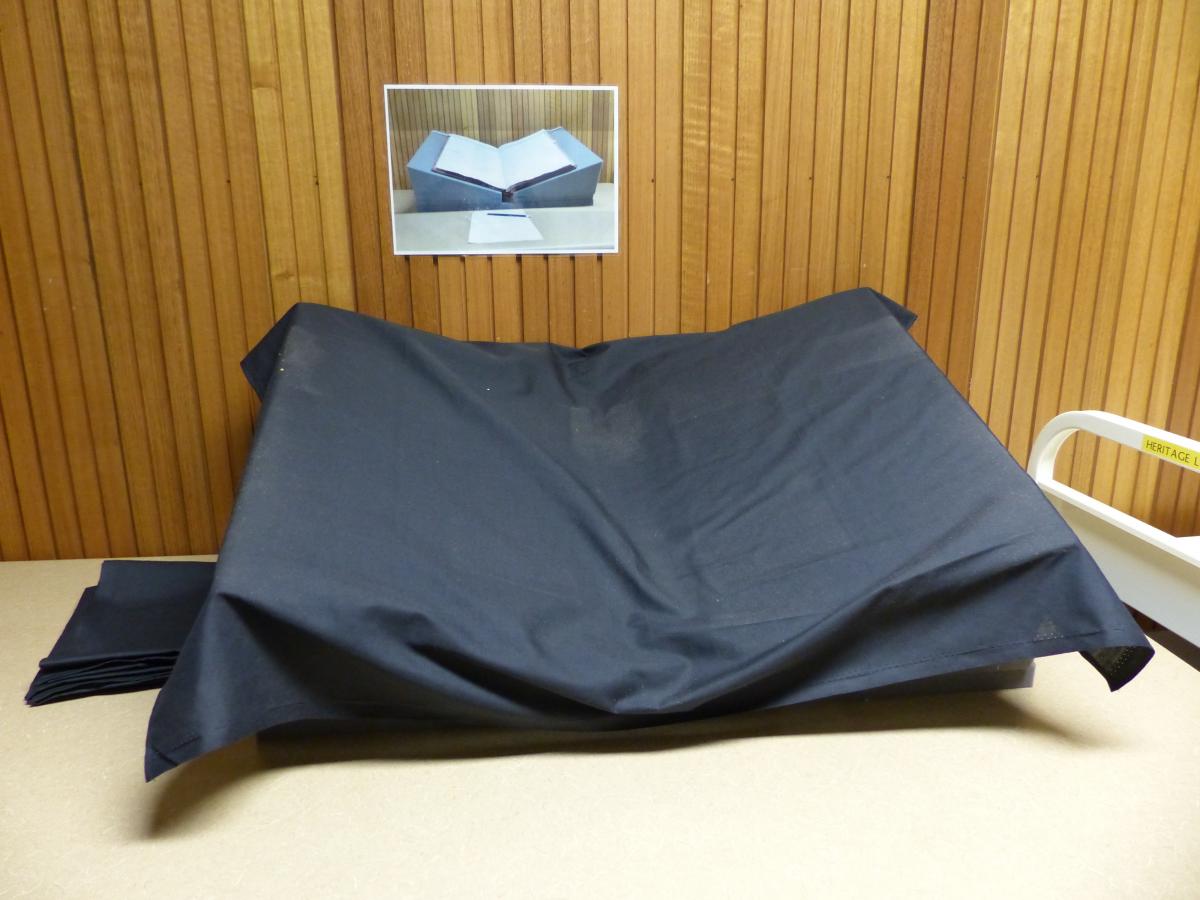
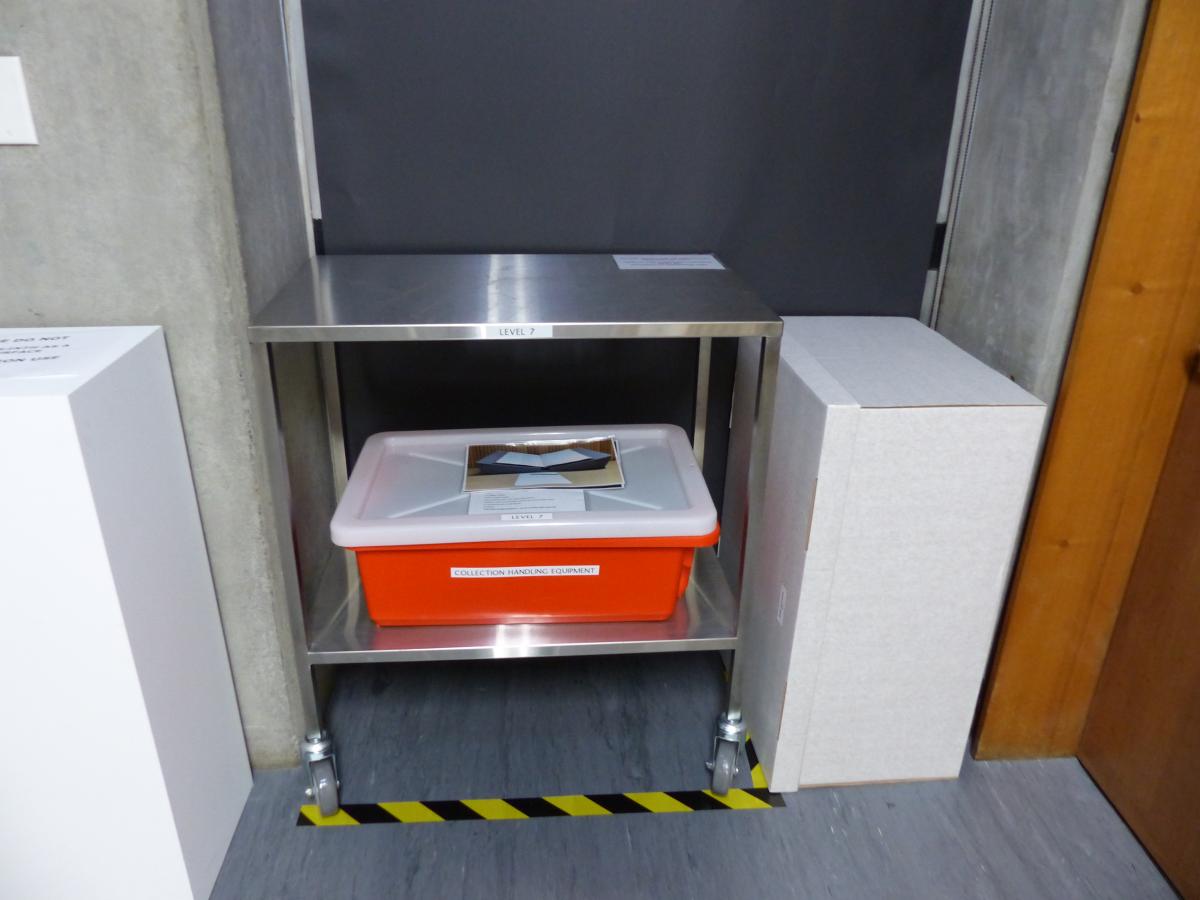

Exhibitions and loans
Gaynor has re-housed works returned from the Thomas Bock exhibition at the Tas. Museum and Art Gallery and Penny Carey-Wells has prepared items for the next ‘internal’ exhibition, Blue to go in the Allport Library and Museum of Fine Art in May.
Tasmanian Museum and Art Gallery
Jennifer O’Connell, Senior Conservator (Painting), represented the TMAG conservation team at the AICCM Managing Risk to Collections Conference in Melbourne. Jennifer also presented an introduction to the session on ‘AICCM Environmental Guidelines for Australian Cultural Heritage Collections’.
TMAG’s Conservation Technician, Lisa Charleston, recently conserved an early twentieth century frame, which is now on display in the gallery. The frame is unusual in its style and surface finish and stands out in comparison to the other frames in the collection. This coincides with a larger frame conservation survey that Lisa has embarked on.
VIC
Arts Centre Melbourne: Australian Performing Arts Collection, Art Collection and the Australian Music Vault
Kylie on Stage touring exhibition
The Kylie on Stage exhibition was initially developed by Arts Centre Melbourne (ACM) for temporary display in the Theatres Building from 17 September, 2016 to 22 January, 2017. It attracted such positive public appeal and enthusiasm that Creative Victoria granted funding for a regional tour June 2017 – January 2019. As a result, the exhibition has toured to the Mildura Arts Centre, Geelong Gallery, Ararat Performing Arts Centre, and the Latrobe Regional Gallery. Further demand for access has also seen this exhibition extend to a final interstate venue. The exhibition is currently being installed at the Western Australian Maritime Museum in Fremantle where it will be on display until the middle of June, 2019.
The exhibition includes 35 complete costumes primarily drawn from Kylie’s spectacular stage wardrobe, which is part of ACM’s Australian Performing Arts Collection. These costumes comprise of multiple parts including: shoes, jewellery, complex headdresses and bustiers. There is also a large amount of complementary 2D material and an additional 25 accessories within the show. Most of the costumes are on open display and in a variety of semi-enclosed and barrier-protected plinths and stages. All of the smaller fragile items and accessories are enclosed display cases.
The Collections team, including Dance and Opera Curator Margot Anderson, Head of Collections, Preservation and Access Samantha Hamilton and Conservator Carmela Lonetti have been closely monitoring the condition of the costumes throughout the tour. A monitoring program capturing the conditions of display was put in place from the beginning of the tour to determine cumulative light, dust, pest and environmental exposure. Upon completion of the exhibition a paper will be written evaluating the touring of a large, primarily textile, exhibition for an extended period of time on open display, across multiple venues.
Art Collection audit
The foundation of the Art Collection at Arts Centre Melbourne dates back to the construction of the buildings in the 1970s and early 1980s. As ACM was being planned and built, works of art were integrally incorporated into the designs of the original foyers of Hamer Hall and the Theatres Building, designed by Melbourne-born, award-winning stage designer, John Truscott.
The Art Collection comprises sculptures, works on paper and paintings, including a series of works by renowned twentieth-century Australian artists such as Arthur Boyd, Roger Kemp, Donald Laycock, Sidney Nolan, John Olsen and Jeffrey Smart, along with a ground-breaking selection of early Western Desert paintings and tapestries. This Collection continues to grow, reflecting the ways in which artists are inspired by the collaboration and immutable connection between the visual and performing arts.
A substantial project of auditing the Art Collection is underway at ACM. Aimed at capturing the condition of all the artworks currently in storage and on display throughout the foyers and surrounding the Theatres Building, the information gathered will be critical in the planning of the relocation of the hundreds of artworks prior to the commencement of the redevelopment of the building commencing late 2019.
Supervised by Collections team members, Conservator Carmela Lonetti and Registrar of Music and Art Jenna Blyth, the project has been largely undertaken by volunteer conservation students Kate Ritchie and Rachelle Bridges and recent graduates Mar Cruz, Marie-Claire Petrowski, and Christine Mizzi. We take this opportunity to thank them for this amazing work.
This project has provided the opportunity to test some new technologies in relation to digital condition reporting, which will be incorporated into a streamlined process linked with our KeEmu database.
The Australian Music Vault (AMV)
The Australian Music Vault (AMV) developed by Arts Centre Melbourne in partnership with the Australian music industry and Creative Victoria, is a celebration of the Australian contemporary music story across all times and genres. This permanent exhibition with changing content is on display until June 2020.
The next highly anticipated changeover display will feature Hip Hop across time, incorporating music, song and dance. Senior Curator of Music and the AMV Carolyn Laffan and Assistant Curator Olivia Jackson have forged some ground-breaking connections with artists within the Hip Hop community across Australia to be able to tell new stories and showcase a variety of objects presenting the cultural heritage and evolution of Hip Hop in Australia. The display will open on 18 March 2019 and will feature a physical exhibition component, online content and associated public programs.
Museum Victoria
Social
Welcome to Penny Byrne who has joined the Collection Development and Access team until the beginning of July. We are very excited to have you back at MV! Good luck to Karen Fisher who has headed to the Performing Arts Centre to work on a project for five months. We are looking forward to a visit.
Research projects
Danielle Measday has been working with her new volunteers Molly Phillips and Sophie Cuthbertson to sort and analyse microplastics found in sediment samples from the Great Barrier Reef. This is part of Dr Stuart Mills’ (Senior Curator, Geosciences) research in the effects of global warming on the mineralogy of the reef (e.g. what minerals are being dissolved first by pH changes in the water). The plastic analysis is related to the part of the research looking at other contributing factors to the health of the ecosystem.
Dani and Rosemary Goodall have started a hazards survey of the Palaeontology collection and have carried out further mercury vapour testing in mineralogy to check on the rehousing of mercury containing minerals that was undertaken last year. They also carried out further testing in IC stores to increase our knowledge of the presence of mercury in that collection.
Exhibitions
As always it has been a busy time for exhibitions. Charlotte Walker has been working on the de-installation of Evolutions, the install of From the Heart and the upcoming Fashion Redux and Gut Feelings exhibitions. Sarah has been busy with the upcoming Women on Farms exhibition, exhibition changeovers in First Peoples and work on Models and Miniatures is ramping up.
Conference attendance
Rosemary attended the IRUG (Infrared and Raman User Group) 13 Conference at the Art Gallery of New South Wales in early December and presented her poster ‘Problems with obtaining good quality degradation spectra on three-dimensional museum items’.
Karen Fisher appeared as a guest on the Triple R summer program ‘Traces’ in January. Traces explored layers of Melbourne’s history with special guests and Karen came on to discuss all things Conservation.
